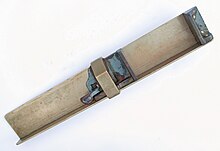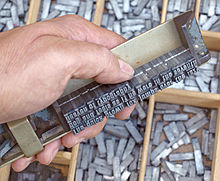Angle hook
As Winkelhaken designates typesetter an adjustable teaching for assembling a line Bleisatz- letters for the high pressure (also: letterpress printing ). In the technical and colloquial language of typesetters, the angle hook is called "trowel".
The angle hook is an angled rail, usually made of nickel silver , which has a fixed and a movable and lockable stop ("frog") made of steel in order to be able to set the desired line width. The distance between the two stops corresponds to the desired line length. The distance is set with several squares and not measured; the typographical units of measurement are cicero and point . Depending on the desired set width, there are angle hooks of different lengths up to 60 cm in length, whereby the 25 cm or 30 cm long copies were standard for the set of commercial printed matter . In addition, there were also angle hooks with two fixed stops for always recurring same line lengths - such as B. in newspaper sentence - common.
By using the angled hook, it was ensured that all lines have exactly the same length and that when the entire sentence, which consists of several lines, is "clamped", a "closed sentence" is created. The accumulation (setting) of letters of different widths in the angle hooks creates a line. This is brought to the set angle hook or line width by adding differently wide, non-printing space blank material for the inter-word spaces (full line width for justified). All lines must be filled evenly so that no word spacing or other blank material can work its way upwards during the printing process - called “skewers”. In order to be able to push the letters out of the angle hook, a "setting line", mostly made of nickel silver , is inserted before setting . The setting line has some "play" in the angle hook so as not to jam.
The closed set is clamped with the locking device in the "form" (the printing form) or a chase . The angle hook was developed by Johannes Gutenberg and used in letterpress printing until it was replaced by the introduction of typesetting machines ( Monotype and Linotype ). But even after that, headings and commercial jobs were still set with it or it was used for filing .
The angle hook or the jib was also used for the practice of demonstrating lead lice to young professionals .



